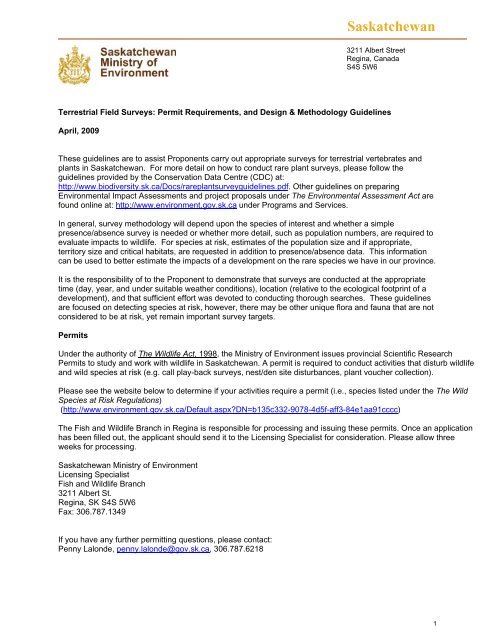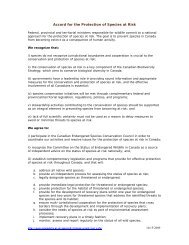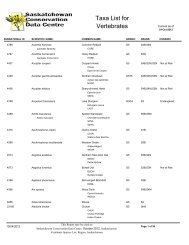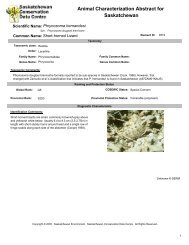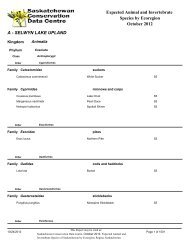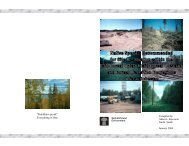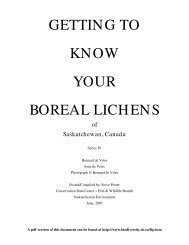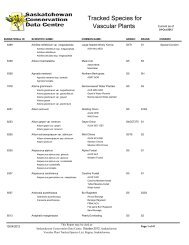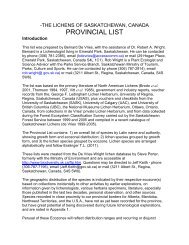Terrestrial Field Surveys - Saskatchewan Conservation Data Centre
Terrestrial Field Surveys - Saskatchewan Conservation Data Centre
Terrestrial Field Surveys - Saskatchewan Conservation Data Centre
You also want an ePaper? Increase the reach of your titles
YUMPU automatically turns print PDFs into web optimized ePapers that Google loves.
<strong>Saskatchewan</strong><br />
3211 Albert Street<br />
Regina, Canada<br />
S4S 5W6<br />
<strong>Terrestrial</strong> <strong>Field</strong> <strong>Surveys</strong>: Permit Requirements, and Design & Methodology Guidelines<br />
April, 2009<br />
These guidelines are to assist Proponents carry out appropriate surveys for terrestrial vertebrates and<br />
plants in <strong>Saskatchewan</strong>. For more detail on how to conduct rare plant surveys, please follow the<br />
guidelines provided by the <strong>Conservation</strong> <strong>Data</strong> <strong>Centre</strong> (CDC) at:<br />
http://www.biodiversity.sk.ca/Docs/rareplantsurveyguidelines.pdf. Other guidelines on preparing<br />
Environmental Impact Assessments and project proposals under The Environmental Assessment Act are<br />
found online at: http://www.environment.gov.sk.ca under Programs and Services.<br />
In general, survey methodology will depend upon the species of interest and whether a simple<br />
presence/absence survey is needed or whether more detail, such as population numbers, are required to<br />
evaluate impacts to wildlife. For species at risk, estimates of the population size and if appropriate,<br />
territory size and critical habitats, are requested in addition to presence/absence data. This information<br />
can be used to better estimate the impacts of a development on the rare species we have in our province.<br />
It is the responsibility of to the Proponent to demonstrate that surveys are conducted at the appropriate<br />
time (day, year, and under suitable weather conditions), location (relative to the ecological footprint of a<br />
development), and that sufficient effort was devoted to conducting thorough searches. These guidelines<br />
are focused on detecting species at risk, however, there may be other unique flora and fauna that are not<br />
considered to be at risk, yet remain important survey targets.<br />
Permits<br />
Under the authority of The Wildlife Act, 1998, the Ministry of Environment issues provincial Scientific Research<br />
Permits to study and work with wildlife in <strong>Saskatchewan</strong>. A permit is required to conduct activities that disturb wildlife<br />
and wild species at risk (e.g. call play-back surveys, nest/den site disturbances, plant voucher collection).<br />
Please see the website below to determine if your activities require a permit (i.e., species listed under the The Wild<br />
Species at Risk Regulations)<br />
(http://www.environment.gov.sk.ca/Default.aspx?DN=b135c332-9078-4d5f-aff3-84e1aa91cccc)<br />
The Fish and Wildlife Branch in Regina is responsible for processing and issuing these permits. Once an application<br />
has been filled out, the applicant should send it to the Licensing Specialist for consideration. Please allow three<br />
weeks for processing.<br />
<strong>Saskatchewan</strong> Ministry of Environment<br />
Licensing Specialist<br />
Fish and Wildlife Branch<br />
3211 Albert St.<br />
Regina, SK S4S 5W6<br />
Fax: 306.787.1349<br />
If you have any further permitting questions, please contact:<br />
Penny Lalonde, penny.lalonde@gov.sk.ca, 306.787.6218<br />
1
Reporting (General)<br />
<strong>Saskatchewan</strong><br />
3211 Albert Street<br />
Regina, Canada<br />
S4S 5W6<br />
<strong>Data</strong> must be submitted to the <strong>Saskatchewan</strong> <strong>Conservation</strong> <strong>Data</strong> <strong>Centre</strong><br />
(http://www.biodiversity.sk.ca) in a timely manner, and can be done using the information provided on<br />
the Rare Species Occurrence data form (http://www.biodiversity.sk.ca/Docs/speciesreportform.pdf).<br />
In place of this form, clients may create their own spreadsheet containing columns of the same fields<br />
identified in the form, and rows of multiple observations for tracked species. Clients who do not return<br />
data to the CDC risk having their accounts suspended.<br />
There are a number of other taxa that the CDC tracks, such as breeding birds and amphibians.<br />
These can also be reported to the CDC using the Rare Species Occurrence data form or for<br />
multiple observations, a custom built spreadsheet.<br />
For further information on reporting, please contact:<br />
Ben Sawa, ben.sawa@gov.sk.ca, 306.787.1142<br />
Flora<br />
Fauna<br />
<strong>Surveys</strong> should be done in all habitats, not just native prairie. If you are describing an area with,<br />
for example, "excessive invasion by exotic species" then you must outline which criteria are used<br />
to define this habitat. We would like to ensure that large cultivated and areas with small areas<br />
dominated by invasive plants do not support rare species such as buffalo grass.<br />
Ensure that you closely follow the rare plant survey guidelines found on the CDC website<br />
http://www.biodiversity.sk.ca/Docs/rareplantsurveyguidelines.pdf. If you are unable to do so, you<br />
must provide appropriate justification and should contact the CDC to ensure that your survey will<br />
be accepted during the technical review of your proposal.<br />
If a small quadrat size (20 x 10 cm) is used to estimate species abundance, we recommend using<br />
several quadrats within each community type. A species area curve analysis can be used to<br />
determine appropriate sampling effort.<br />
A measure of percent foliar cover is preferable to frequency within a quadrat.<br />
The population size of each rare plant occurrence should be reported (area covered), as well as<br />
the number of individual plants in that occurrence.<br />
The phenology/life stage of each rare plant should also be reported.<br />
Wildlife surveys should be focused on species-at-risk (see the Species at Risk list on the CDC<br />
website). Because the majority of rare species are avian, a general breeding bird survey should<br />
be conducted to screen for all species of concern. Anuran studies may also be conducted during<br />
breeding bird surveys to detect Northern leopard frog or local populations of additional<br />
amphibians. If work is proposed for areas occupied by swift fox, Ord’s kangaroo rat, or other<br />
mammals of concern, it should also be designed to maximize their detection. <strong>Surveys</strong> should be<br />
done throughout the project area and not just in representative habitats to ensure that any rare<br />
species are adequately detected.<br />
2
Fauna (continued)<br />
<strong>Saskatchewan</strong><br />
3211 Albert Street<br />
Regina, Canada<br />
S4S 5W6<br />
An updated list of Species at Risk that occur in <strong>Saskatchewan</strong> can be found on the CDC website<br />
http://www.biodiversity.sk.ca/Docs/SpeciesAtRiskinSK.pdf. Please note that this list does not<br />
include all of the S1-S3 species ranked by the CDC, which should still be identified in survey<br />
efforts.<br />
To generate both a species list for the impacted area as well as their relative numbers, we<br />
recommend using systematic, standardized point count surveys along line transects. For species<br />
such as Burrowing Owls that may be in an area, their presence can be confirmed by meandering<br />
searches and inspecting roost and nest burrows (e.g.: pellets, feathers, whitewash), or by using<br />
call playback surveys (Note that a Scientific Research Permit is required for this). It is essential<br />
that only qualified persons inventory wildlife that may be in the project area.<br />
All breeding bird surveys must be done during the appropriate times of the year (mid May – 1 st<br />
week in July for songbirds) and day (up to 4 hours after sunrise for diurnal species; from 2 hours<br />
before sunset for crepuscular/nocturnal species), and only during acceptable weather conditions<br />
(see Table 1). <strong>Surveys</strong> should be done twice during the breeding season, at least 2 weeks apart.<br />
Amphibians are also most easily detected using auditory point counts and by conducting visual<br />
surveys for adults and larvae in appropriate habitats. We suggest following the North American<br />
Amphibian Monitoring Protocol guidelines for surveying frogs in <strong>Saskatchewan</strong> (USGS, 2005;<br />
found online at: http://www.pwrc.usgs.gov/naamp/index.cfm?fuseaction=app.protocol. In general,<br />
a biologist will listen for 5 minutes at all wetlands or potential habitats in the project area, and<br />
place their survey points ~ 500 m - 800 m apart. The best time to survey is after a rainfall, and<br />
approximately 30 minutes after sunset or in the evening. At each survey station, biologists will<br />
record an amphibian calling index for each species heard (e.g.: individuals can be distinguished<br />
vs. constant chorus). Surveyors are also pointed to pay particular attention paid to the appropriate<br />
weather conditions for conducting these surveys (sky, wind and noise index).<br />
Proponents must also identify any migratory staging areas for birds that may be impacted by the<br />
development; consider proximity and noise levels when determining if an area may be impacted<br />
(i.e.: survey the areas surrounding the development).<br />
Activity restriction guidelines have been identified for many sensitive taxa and can be found on<br />
the CDC website at: http://www.biodiversity.sk.ca/Docs/SKactivityrestrictions.pdf. These buffer<br />
zones should be respected when conducting surveys. If they must be breached, a Scientific<br />
Research Permit may be required.<br />
3
Table 1. Acceptable and unacceptable weather conditions for conducting<br />
songbird surveys in <strong>Saskatchewan</strong><br />
Wind<br />
(Beaufort Scale)<br />
Acceptable Unacceptable<br />
Beaufort 1 (5<br />
Precipitation None Light rain<br />
Light fog Hard rain<br />
Misty drizzle Snow<br />
Drizzle Heavy fog<br />
Temperature > 6 º C < 6 º C<br />
Ambient Noise No noise.<br />
Moderate noise. Likely can't<br />
hear birds beyond 200 m.<br />
Faint noise. Likely can't hear<br />
birds beyond 400 m.<br />
Loud noise. Likely can't hear<br />
birds beyond 100 m.<br />
<strong>Saskatchewan</strong><br />
3211 Albert Street<br />
Regina, Canada<br />
S4S 5W6<br />
For more information contact the Fish and Wildlife Branch in Regina at: (306) 787- 2314.<br />
4


